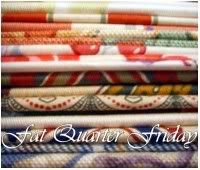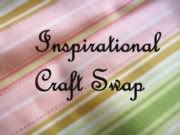Woven basket tutorial
I'll just caveat this by saying that I have made a couple of mistakes, but you can learn from them so my pictures might not match what I'm saying. That's because I'm human, not a machine and sometimes I get it wrong (and then I swear a lot).
I've labelled this as a fat quarter tutorial even though, strictly speaking, it takes 3/4 yard of fabric to make. But you can make it with two nice FQs - or even some scraps.
You will need:
Fabric 1- 2 pieces of 10"x16"
Fabric 2- as above
Lining - 2 pieces of 10.5"x16"
Iron on interfacing (light to medium) - 4 pieces of 10"x16"
Very heavy iron on interfacing - 2 pieces, but do not cut until the weaving is done.
Fabric 1,2 or lining fabric (your preference) - 1 piece 7"x15"
Very heavy iron on interfacing - 1 piece 3.5"x12.5"
A piece of bag bottom or card (I forgot to put mine in, durrr!)
Prepare fabric:
You can make this with strips if you have them (eg a jelly roll) or even ribbon strips. These instructions assume you are using yardage.
Iron on the medium interfacing to the wrong sides of all fabric 1 and 2 pieces. This keeps the fabric straight for the next steps.
Cut fabric 1 horizontally, into 2" strips (you'll have 5 strips for each piece)
Cut fabric 2 vertically, into 2" strips (you'll have 8 strips for each piece)

For 4 pieces of each fabric you will only need to do one side. If your fabric has a right/left top/bottom make sure you do two of each.
Lay your horizontal strips on a desk, with the unfinished edges top and bottom.



Continue on the next row, alternating each row. Use a pin at each end, until you get to the top. Pin along the top. (I did take a picture, but it didn't come out for some reason) You will end up with a checkerboard effect.
 Make sure that you butt each piece close to its neighbour, otherwise your interfacing will show and it will look rubbish. You can see here how my ironing board was showing through a crack. Fiddle with the pieces until they all match up.
Make sure that you butt each piece close to its neighbour, otherwise your interfacing will show and it will look rubbish. You can see here how my ironing board was showing through a crack. Fiddle with the pieces until they all match up.PRESS with a hot iron. Don't "smooth" the iron across, just press down firmly for a couple of seconds, lift the iron and repeat on the next section.
Carefully sew around the edges using a basting stitch (I also used my walking foot to minimise movement)

To make it up:
Iron the interfacing to the fabric pieces. Take your time and use a pressing motion. Make sure it is all stuck down well.
Put the pieces right sides together and make sure they fit together, trim if necessary.
Sew the two fabric/interfaced pieces together along the sides and bottom.
 This is a winged needle. I used this to get through all the layers (because that interfacing is thick). You will need to use a needle for heavy duty sewing. I noticed my machine was missing stitches and the thread kept snapping. I changed to some better quality Gutterman thread for the top stitching and I had no more problems - so try to use the best quality thread you have.
This is a winged needle. I used this to get through all the layers (because that interfacing is thick). You will need to use a needle for heavy duty sewing. I noticed my machine was missing stitches and the thread kept snapping. I changed to some better quality Gutterman thread for the top stitching and I had no more problems - so try to use the best quality thread you have.Cut a 3.5" square from the bottom 2 corners. Open up the trimmed corners and squash down so that the side seams match up.
 Carefully sew along the corner seams. I did two lots of stitching for a good seam.
Carefully sew along the corner seams. I did two lots of stitching for a good seam.Turn the basket the right side out, and press well to get a firm and square shape.
Make the handle:
Fold the fabric in half, press, then each half into the middle crease and press again. Iron the heavy interfacing into the middle between the creases.

To attach, fold the ends of the handle (without interfacing) over the top of the basket, and then back onto the front of the basket, then stitch. (The handle will be stitched front and back of the basket)
Fold the handle UNDER the basket, and repeat on the other side.
The bit I forgot:
Measure your bottom piece and cut a bag bottom to size. Cut this in half legthways and glue each piece in the bottom, either side of the centre seam.
Sew the lining:
As for the outer shell, but only sew a few inches on the bottom edge. Leave a big gape in the middle (most of the length of the bottom, because you need a lot of room to push the basket through).
Put the basket into the lining, right sides together.
It will be very fiddly - sew the top edges together. Because the handle is tight, do one side at a time. Put your hand through the lining gap to move the handle to the opposite side to the one you are stitching, so that any distortion is on that side, and your stitching side is smooth.
Pull the bag through the hole and stitch the bottom closed.
Because your lining is slightly bigger than your basket, it will show proud over the top. This is on purpose, so you don't have to deal with trying to press the blazes out of that heavily lined top seam.
Press all the sides and corners to get a neat finish.

I'm certainly going to make some of these in Christmas fabrics to fill with pine cones. I would also love to have a go at a ribbon version.


















14 comments:
This is Great!! I can feel a jelly roll project coming on!! x
This is such a great project! I'll be linking to this!
Wow, that is stunning! I would love to try one, but think it may be beyond my novice machining capabilities!
April xx
adorable! so crafty, you are. these would be great for Easter baskets, too.
What a great tutorial. I like the end product and you described the process very well.
I love it!!
I can also see why it caused a late lunch....must have taken ages!
xxx
You sure got your game on with your serger! I haven't touched mine since purchase - waiting to go for lessons, but I think I should just get on with it!
-- Michele
Your tutorials are GREATS!!!!
Kisses from Italy
Manuela,
Thanks for visiting me - I love your work too! That basket is simply awesome looking!
Thats one of those projects that sets my fingers itching! thanks I will add it to my list!
This is really cute! Bookmarking so I can come back and make it soon.
wow, what a gorgeous basket! thank you for the tutorial...=)
Very cute basket! Thanks for sharing how you made it. :)
Hi, I made one of your baskets last summer and would like to send you a picture of it! I LOVE it and gave it to one of my sisters as a gift! I would love to make another one!
Post a Comment